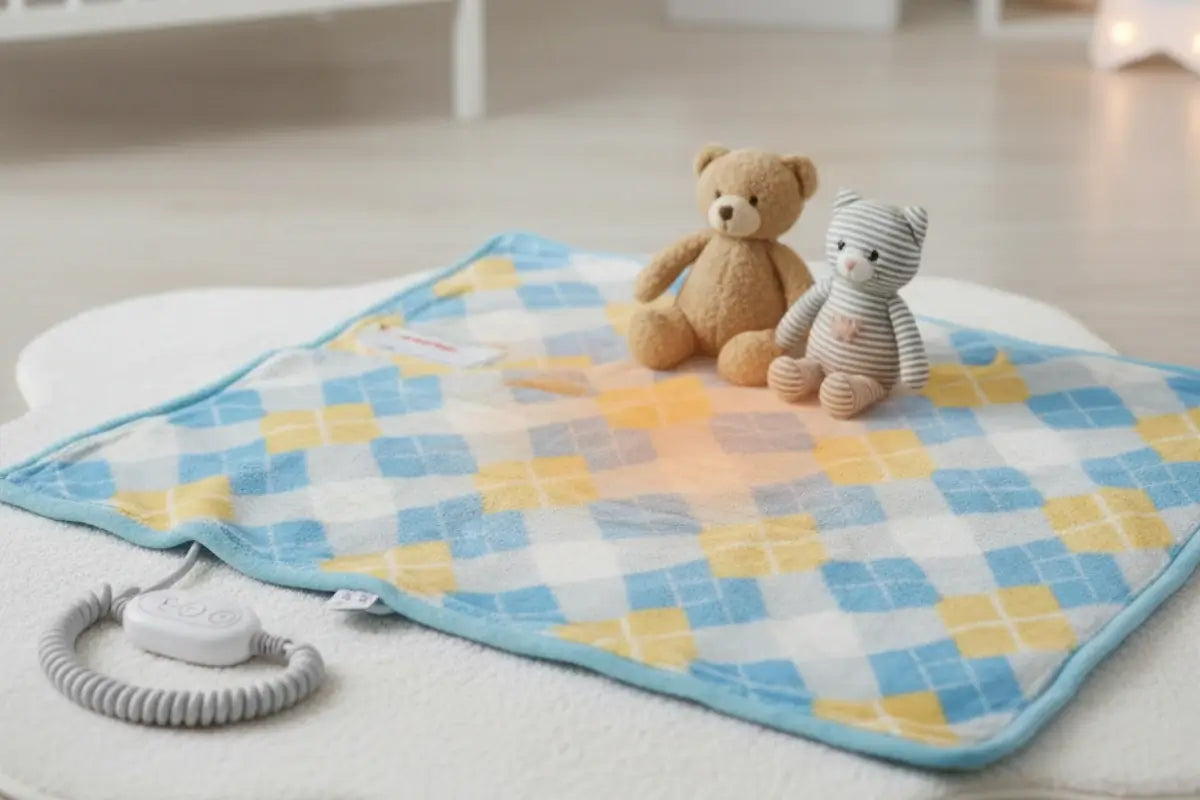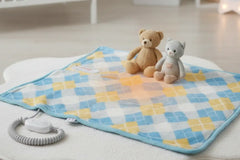Are Heated Blankets Safe for Toddlers?

Heated blankets feel cozy, but they can put toddlers in real danger. From burns to overheating, electric shocks, and even fire, these seemingly harmless blankets carry hidden risks.
Parents often wonder if they are safe, but the truth is startling. Knowing the dangers and safer alternatives can protect your child and ensure peaceful, worry-free sleep.
Key Takeaways
Avoid Heated Blankets: They pose risks of burns, overheating, fire, and electric shock.
Protect Against SIDS: Overheating during sleep increases sudden infant death risk.
Choose Safer Alternatives: Use layered pajamas, sleep sacks, or breathable crib sheets.
Keep the Room Comfortable: Maintain a nursery temperature between 65–72°F.
Prioritize Safety: Skip cords, wires, and loose blankets to reduce strangulation and suffocation dangers.
Are Heated Blankets Safe for Toddlers?
Heated blankets are unsafe for toddlers due to risks of overheating, burns, fire, electric shock, and strangulation from cords.
Pediatric research links overheating to higher SIDS risk, and toddlers’ delicate skin burns quickly.
The American Academy of Pediatrics advises against heated blankets, recommending layered pajamas, sleep sacks, and maintaining room temperatures of 65–72°F for safe, comfortable sleep.

Risks of Using Heated Blankets for Toddlers
Heated blankets can cause toddlers to overheat
Heated blankets may seem cozy, but for toddlers, they can pose serious risks. Research published in Frontiers in Pediatrics shows that heat stress and hyperthermia are common in sudden infant death syndrome (SIDS) cases.
Overheating can directly trigger dangerous hyperthermia or indirectly affect vital functions like breathing and heart rate.
Studies also reveal that infants face nearly a threefold higher risk of SIDS on days when temperatures exceed 29°C (84.2°F), making overheating a major concern.
Since toddlers and young children have immature systems for regulating body temperature, they are especially vulnerable, body temperatures above 104°F (40°C) are already considered very high, and 108°F (42.3°C) is life-threatening.
Heated blankets, particularly when combined with extra layers, can easily push them toward unsafe levels.
That’s why organizations like the American Academy of Pediatrics strongly advise against heated blankets or loose bedding.
Instead, they recommend using a sleep sack or keeping the room comfortably cool to reduce the risks of overheating while ensuring safe, restful sleep.
High heat may burn a toddler’s sensitive skin
Toddlers’ skin is far more delicate than adults’, which makes heated blankets especially risky. Research in the Archives of Dermatological Research shows that young children have thinner, more permeable skin barriers that don’t fully mature until around age five.
This means their skin is softer and more prone to irritation, burns, and inflammation. Medical data further highlight the danger: the Starship Child Health Clinical Guidelines report that liquids at just 60°C (140°F) can cause a serious burn in under five seconds, and hot surfaces can injure a child’s skin in as little as one second.
Sadly, there are real cases of harm, such as one described in the Journal of Burns, where a three-year-old suffered a severe burn after a heated blanket malfunctioned during surgery.
Because toddlers’ skin can be damaged so quickly, child safety organizations, including the American Academy of Pediatrics, strongly advise against heated blankets and recommend keeping a toddler’s sleep space bare, cool, and safe.
Electrical parts increase fire and shock risks
Heated blankets may feel cozy, but for toddlers they come with serious dangers. In the UK alone, faulty or overheated electric blankets cause around 1,000 fires every year, leading to over 20 deaths.
Shockingly, about 35% of these blankets are estimated to be faulty, making the fire risk even higher if left on too long or overnight.
Fire safety agencies like the NFPA and ESFI warn that many incidents involve older blankets with frayed wires or damaged cords.
Since 2010, over 400,000 unsafe blankets have been recalled worldwide for fire or electrocution hazards, according to ACCC Product Safety.
Beyond fire, the risk of electric shock is even more concerning for toddlers, children are smaller, more vulnerable, and their bodies are less resilient, making shocks potentially catastrophic.
Guidance shared by Medical News Today also cautions that electric blankets should not be used for children at all, as well as for pregnant people or those with certain health conditions. For parents, the safest choice is to avoid heated blankets entirely when it comes to toddlers.
Cords and wires can pose strangulation dangers
Heated blanket cords can pose a serious strangulation risk for toddlers. Keep all cords out of reach, ideally several feet away, and cover them with protective sleeves or secure them behind furniture. If a toddler gets tangled, remove the cord immediately and ensure their safety.
Unsafe sleep setups raise SIDS concerns
The American Academy of Pediatrics warns strongly against using heated blankets or any soft bedding in a baby’s sleep space, since they raise the risk of suffocation and sudden infant death syndrome (SIDS) by causing overheating.
Instead, they recommend safer options like wearable blankets, dressing your child in one extra layer than you’d wear, and keeping the room cool and comfortable.
Research backs these concerns: findings published in the Journal of Epidemiology suggest that overheating can overwhelm an infant’s ability to regulate breathing and arousal during sleep, making thermal stress a serious risk factor for SIDS.
Real-world data also highlight the dangers, reports from Rush University Medical Center found that 99% of sleep-related infant deaths happened in unsafe environments, often with soft bedding or adult beds.
While toddlers regulate temperature better than newborns, sleep studies show they still overheat easily, leading to restless nights and fragmented sleep.
Public health organizations also advise against electric blankets for young children altogether, emphasizing that a cool, safe sleep setup is always the best choice.
Blanket materials may trigger allergies or irritation
When choosing heated blankets for toddlers, material is crucial. Synthetic fabrics like polyester can irritate skin, and wool may be uncomfortable for sensitive children.
Chemical treatments can trigger allergies, so labels should be checked carefully. Even hypoallergenic blankets are not guaranteed safe.
Natural fibers like organic cotton usually cause less irritation and are often the best choice for comfort and safety.
Safety Features to Look for in Heated Blankets for Kids
Automatic Shut-Off Function: Ensures the blanket turns off after a set time to prevent overheating or accidents.
Low Voltage Technology: Uses safer, low-level electricity to reduce any risk of electric shock.
Overheating Protection Sensors: Detects when the blanket gets too hot and automatically adjusts or shuts it down.
Flame-Resistant Materials: Made from fabrics that resist catching fire, adding an extra layer of protection.
Secure and Child-Friendly Controls: Easy-to-use buttons or settings designed so kids can’t accidentally misuse them.
Certified Safety Standards and Labels: Look for blankets tested and approved by trusted safety organizations.
Proper Sizing and Fit for Kids: Smaller sizes ensure comfort and safety, preventing extra fabric from bunching or tangling.
Safer Alternatives to Heated Blankets for Toddlers
Dress Your Toddler in Warm, Layered Pajamas
Instead of using heated blankets, which can carry risks like burns, overheating, or even fire hazards, pediatric sleep experts recommend keeping your toddler’s room comfortably cool, around 65 to 70 degrees Fahrenheit, while dressing them in layered pajamas.
This approach is not only safer but also more flexible, since you can add or remove layers as needed.
Research on children’s sleep environments shows that breathable fabrics and layers help manage both heat and moisture, supporting steady body temperature through the night.
Materials like cotton are especially encouraged by organizations such as the Sleep Foundation, as they’re soft, chemical-free, and breathable, unlike fleece or synthetics that may trap heat.
Parents can also choose snug but comfortable pajamas, even letting toddlers pick their favorites to make bedtime more enjoyable.
The American Academy of Pediatrics also advises that layered sleepwear or wearable blankets are better than loose blankets, reducing risks of entrapment. In short, warm pajamas and layering offer simple, effective, and far safer comfort than any heated blanket.
Choose Sleep Sacks or Wearable Blankets Instead of Loose Covers
Heated blankets can risk burns or overheating, while loose blankets can cause suffocation. Sleep sacks and wearable blankets stay in place, keeping toddlers warm without covering the head or restricting movement, and can help reduce SIDS risk. Most are suitable for toddlers over six months, offering safer, consistent comfort.
Use Thermal or Fleece Crib Sheets for Extra Warmth
Thermal and fleece crib sheets keep toddlers warm without a heated blanket. Thermal sheets trap heat, while fleece sheets are soft and naturally warm without causing overheating. They are safe, easy to use, and make cold nights more comfortable.

Keep the Nursery at a Comfortable Temperature
Pediatricians and the American Academy of Pediatrics recommend keeping a baby’s room between 68 and 72 degrees Fahrenheit (20–22°C) year-round, whether it’s the middle of winter or a hot summer afternoon.
This range helps babies and toddlers stay comfortable without overheating, which is especially important because young children can’t regulate body temperature as well as adults.
Research shows that thermal stress, such as a room that’s too warm or heavy bedding, has been linked to a higher risk of Sudden Infant Death Syndrome (SIDS), particularly in summer months.
In fact, studies have found that even small increases in daily temperature can raise SIDS risk, while good airflow and well-ventilated rooms lower it.
Global health organizations emphasize creating a safe sleep environment by keeping the head uncovered and dressing little ones in breathable sleepwear or wearable blankets rather than loose blankets or heated devices.
Maintaining a moderate room temperature not only keeps your child comfortable but also provides an important layer of protection against overheating and sleep-related risks.
Try Safe, Child-Friendly Space Heaters if Needed
When it comes to keeping toddlers warm, heated blankets often carry higher risks than child-friendly space heaters.
Blankets sit directly on the child’s body, increasing chances of burns, overheating, or even suffocation if cords or fabric cover the face.
Space heaters, on the other hand, warm the room more evenly and modern child-safe models usually include protections like tip-over shut-off, overheat sensors, and cool-touch exteriors.
Still, safety depends on how they’re used. Nationwide Children’s stresses that space heaters should never run while adults are asleep or out of the room, and young children should not be left alone with one.
The Livonia Fire Department News also highlights the importance of choosing heaters with UL, ETL, or CSA certifications, keeping them three feet from flammable items, and unplugging when not in use.
While statistics show space heaters cause more overall injuries than blankets, experts generally caution against heated blankets for toddlers because children cannot easily regulate body heat or remove them if too hot.




